What is Human?
Human and nonhuman compared ...
You don't live in a world all alone. Your brothers are here too.
Albert Schweitzer
The purpose of human life is to serve, and to show compassion and the will to help others.
Albert Schweitzer
Overview
Focus questions & responses
- What is human?
- How do we decide?
- What were we before human?
- How are humans different and the same as other primates?
- How are we different than our ancestors who weren’t human?
- What are the consequences for how we decide what is human?
- What are human rights? Who gets to decide?
- What are civil rights? How are they enforced?
- What rights should nonhuman organisms have?
What make us human?
Characteristics of humans 
- Walk upright, bipedal, skull on top of spine versus at an angle.
Source - Run for long distances.
- Opposable thumbs - is the ability to touch our thumb to each of our fingers; enableling our ancestors to develop dexterity in the manipulation of object, which lead to the use of objects as tools and eventually to make and use tools to eat more protein and grow bigger brains. Not only are our hands capable, but they are like an independent sense organ that is very sensitive to touch. We are able to feel temperature differences of objects, air, and water. Feel texture and know if surfaces are smooth, uneven, and sharp. We are able to blindly sense the identity of objects. We use our hands to carry objects, scoop water, construct tools, hunt, eat, and communicate. It is very likely humans communicated with hand gestures long before they communicated verbally. See also communication of primates
- White around the iris of the eyes (sclera). Humans and chimpanzees eyes have a larger area of sclera which enables other people to infer where you are looking.
- Humans are the only animal with a chin.
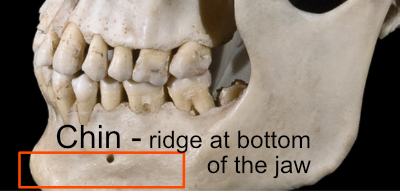
- Blush - humans are not the only animal that blushes.
- Persistent curiosity, habits of mind
- Collaborate with family, friends, & strangers, across gender, animals, and other tribes or groups. For example cooperates to stand in an ordered line. Imagine a pack of dogs, cats, chimpanzees, in food line or at a community picnic, thanksgiving dinner, or cinema line.
- Imagine to create - see a point in the end of a stick, a scraper in a rock, and combine two objects to make one tool ...
- Process food: butcher animals, fillet fish, dry food, cook, smoke, salt, preserve
- Develop tools, technology, domestication of plants and animals
- Foresight - anticipate and see the future
- Fear the future
- Complex brain
- Logic
- Language and communicate across time and long distances, gossip, tell stories, art, music ...
- Social
- Read people's body expressions to anticipate their thinking one, two, three, four, or more steps into the future.
- Able to speculate on what other people are thinking and to speculate that they are capable of thinking about what I am thinking that they are thinking ... and so forth...
- Hate for our enemies
- Create ideas that are not real or have physical properties: art, music, fiction, speculation, lies, stories, myths, explanations, theories, ...
- Consciousness aware that we are curious, social, and have awareness of our selves and individuals.
- Have the capacity to intervene for ourselves and to change the world.
- One form of intervention is learning and teaching.
How to build a human!
Read: How to build a human
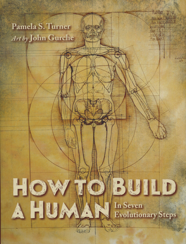
Excellent source for middle level and above. Only weakness in the story is not including epigenetics, (changes in an organisms by modification of gene expression rather than alteration of the genetic code) along with the environmental impacts on evolution. Otherwise, an excellent source.
Comparisons of human and non human organisms
Primate communication
Gestures and sign language
A field study in 2018 found chimpanzees, bonobos, gorillas, and orangutans used 33 different gestures to communicate with many of these animals using the same gesture in the same manner. What they communicate is orders: Give me that. Come closer. Groom my fur. Stop that… Humans use many more gestures and sign language that goes beyond orders to include social contexts, emotions, and attitudes. Thumbs up, fist bump, okay signal, and hands to for a heart. Source
Vocal communicaton
Humans and other primates make vocal noises using the larynx. However, non-human primates also have a set of muscles called vocal membranes, above the vocal cords, which make it harder for them to control the sounds they make. Humans do not have these membranes and are able to more precisely control the sounds they make.
- Smithsonian magazine
- Science - Evolutionary loss of complexity in human vocal anatomy as an adaptation for speech. Takeshi Nishimura et al. August 12, 2022. see image 1, image 2
Animal self awareness or consciousness
Elephants
- Seem to have self awareness, consciousness, if, then thinking to explore, and the ability to think about what other elephants are thinking and cooperation ... Source: Through the Worm hole (5:50)
- Elephants were brought to a giant mirror where they viewed the image and explored it until they seemed convinced it was their own image in real time, not a picture, or video, of them self or another elephant. Then they explored areas of their body they could not see with out the mirror, nose, mouth, ...
- Two elephants were shown an apparatus where they worked together to solve a problem. Cooperation for problem solving.
- Elephant human relationship. Elephant rushes into stream to help man (0:53) ...
Dolphins
- Self-Consciousness See Source: Dolphins in the mirror (5:03)
- Dolphins cooperate to create a circle of mud that act as a wall or net around a shole of fish. When the circle is closed, the fish attempt to escape by jumping over the mud, where the dolphin catch them. Source (1:38) Circles were observed from space satellites off the coast of southern Florida. Source What on Earth? documentary
- Dolphins off the coast of Laguna, Brazil cooperate with fishermen by herding mullets (fish) towards the shoreline, then signal the fishermen the best time for the fishermen to cast their nets. Source (3:41)
Octopus
- The common octopus (Octopus vulgarius) has 500 million neurons, 5 times what hamsters have, large brains and can manipulate objects with their arms. The have been observed to steal fish from fisherman's nets, open bottles, solve puzzles, interact with humans, interact with mirrors, and appear to have consciousness. What the Octopus Knows by Olivia Judson January/February 2017, The Atlantic.
Animals that teach their young
- Meerkats take an active role in teaching their pups how to eat centipedes. Source
- Teacher ant teaches a student ant how to find food. Source
Human Chimpanzee musculature comparison
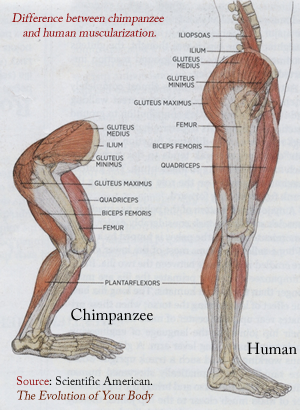
Human Ape musculature comparison
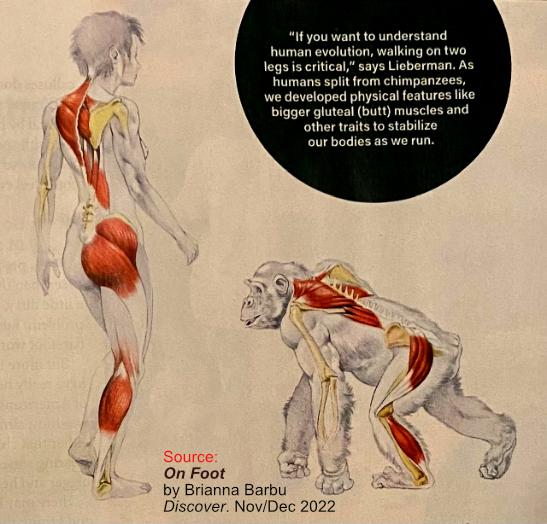
Human Chimpanzee skin hair comparison
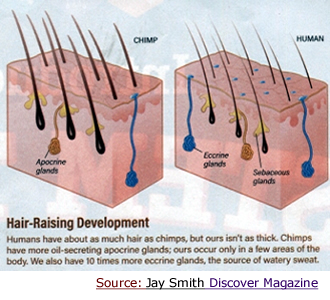
Primate family evolution comparison
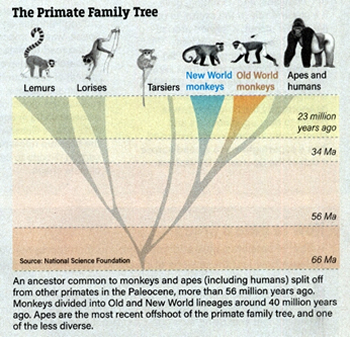
Neanderthals may have used their hands differently from humans If you were to greet a Neanderthal with a handshake, it might feel a little awkward. Homo neanderthalensis had chunkier fingers compared to human digits — and used their hands differently from us, a new study suggests. However, they were able enough to make tools, clothes, cave pinting, sculpture, and other artifacts. Read more ...
Humans change in the same ways as other animals living in the same environements. Variation in hunter-gather behavioral actions converge with the same 15 characteristics common in birds and mammals in the same local regions. Traits such as: diet, movement, social group sizes, and parental interactions. However, social learning, linguistic distance between groups, and cooperation were more imporatant to determine human behavioral variations. Source: Science January 15, 2021. p 292, & 235.
Consequences for the decision of what is human
What are the consequences for how we decide what is human?
Besides the philosophical and educational consequences of what we think of ourselves and others, the differences between us and other living organisms, and how we decide to treat both human and non human organism has legal consequences.
Consequences, which are becoming more significant with recent advances in medicine, biology, neuroscience, and genetics demonstrate how it is more challenging to decide, how to treat different organisms, what is a living human, and how to define and proceduralize them within a legal system.The decision we make are very serious, as we use them to decide who or what deserves the respect and dignity we give to being human and what degrees of respect and dignity to giveother organisms.
Here are ideas and questions to consider.
Historically a legal definition of a living starts with birth and ends with death and what is human has been understood as the organism's relationship to his parents and their ancestors (animals of one species produce animals of the same species). However, recent events raise questions, whose answers are not resolved comfortably based on these understandings.
Considered these examples:
Organs donated and transplanted into others. The organ is considered living, never dead, & ownership is transfered from one conscious human to another.
What about these?
- An organ, kidney or bladder, grown in a lab. Is the organ human? What would make it human? Who has legal ownership?
- An organ with human tissue is grown in a pig? Is it human? What would make it human? Who has legal ownership?
- Cloned cells. What makes them human?
- Human genes edited into mouse genes. Is the mouse human? How many human genes would make it human?
- Mouse model with human DNA to model drug interactions with the immune system. Is it partly human?
Archaeologist used to define fossils as human by certain characteristics of bone structures and artifacts discovered with them. With the sequencing of the human genome, genetic similarities is used. However, there is no one human genome. There are billions of them alive and dead and they are constantly evolving.
Considered these examples:
- Can humans be defined genetically?
If so, where does the common genetic heritage of humans begin? Which of out ancestors are or are not human? Neanderthal? Denisovian? Homo habilis? …
- What is a deciding factor that determines a human genome?
- How are genes used to define human? As they are used to make a person or the information potential in making diverse humans?
A definition of human is used to determine what has the status of a human and therefore, given protection as a member of the human family? If the example of birth and death is used, then what protection should be given to humans before they are born and after they die?
Considered these examples:
- Protection for the embryo and fetus from research, genetic editing, genetic selection, parental abuse, accidents, abortion,
- Protection for human parts? organs, tissue, cells, genes,
- Protection for human parts that make other humans? sperm, eggs, stem cells, embryos,
- Protection for the body after death. Human remains, organ harvesting, burial, grave robbery, DNA sampling of ancient bones,
How should death be determined?
- Heart stopping
- Lack of brain activity
- Designate certain areas of the brain as necessary for life.
Related resources
Educational theory related to human characteristics